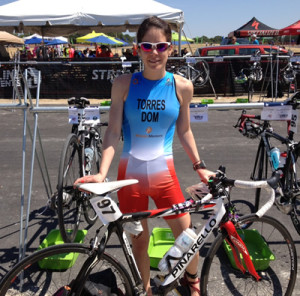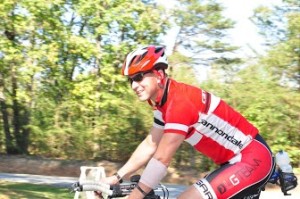It’s no secret that high-level training, proper conditioning, and resilience will contribute to the creation of an above-average athlete. Three local soccer players made that commitment years ago when they began training with Athletic Mentors. Besides having strong dedication to their sport in common, Maggie Harma, Carley Rice, and Kendra Sosnoski are all Gull Lake High School graduates and now collegiate athletes. Kudos to our trio of alumni!
In the first of this inspiring series, allow us to introduce you to Maggie Harma.
Up Close and Personal with Maggie Harma
Harma began her career as a goalkeeper at 10–years-old and joined AM her sophomore year of high school. Her career at Gull Lake High School was comprised of 53 shutouts, a 93.7 save percentage, and two MHSAA state titles. Harma was confident that she wanted to play soccer in college, so she took every opportunity possible to improve at AM.
“My coaches at school kept me technically skilled, but once I started training with Athletic Mentors, I feel like I became a better, stronger, faster player,” she said. Having already learned collegiate lifts and participating in conditioning routines, Harma was ahead of most freshman and physically ready to take on Division II athletics.
Harma spent her freshman season at Wayne State College in Wayne, Nebraska, studying a pre-professional degree. Her transition was one of the most extreme.
“The transition from high school to college, especially with athletics is insane,” she said. “You have to be 100 percent dedicated and in love with your sport, or you will grow to resent it.”
In addition, Harma said that as a student-athlete who’s pushing their limits, she learned a lot about herself fairly quickly. “You realize what you can do – managing a difficult school schedule, attending practices and conditioning, and balancing meets and a social life,” she said.
As she recalls her first season, Harma is elated to have contributed to the Wildcat soccer squad. She had the honor of starting most games as their goalkeeper and because the program is being rebuilt, helped the team drastically improve their statistics by cutting the goals scored on them in half, doubling the amount of shots and doubling the amount of scored goals.
“It was really good for me to get to play as a freshman. I was able to work out the kinks of the system and adjust to the game,” she said.
Her first year at WSC has still been trying, though. Being far away from her family and friends left her feeling mentally weak and not as fully committed. She half-wanted to be in Michigan, and half-wanted to be at WSC. The greatest thing she has learned can be used as advice for all college-bound athletes:
“It’s so much easier said than done, but jump in with two feet. You have to completely submerge yourself,” Harma said. “In order to be successful, you have to fully understand that this is the next chapter of your life, and embrace where you’re going.”
In order to full commit herself to school and soccer, Harma has made the decision to transfer to a school closer to home. Although this isn’t the answer for everyone, she feels that her performance and dedication will increase immensely at a location that’s more of a fit. She plans to condition hard through the summer and hopes to earn a starting spot on the squad of her next team. Look for Harma next fall at a college or university much closer to you!




 Our Hockey Site
Our Hockey Site Team AM
Team AM



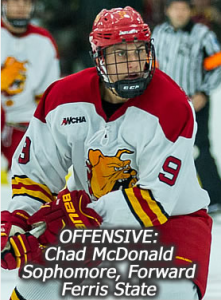 Hat’s off to our own hockey program alumni, Chad McDonald, who’s now a Sophomore Forward with Ferris State University. Chad was nominated as the WCHA Offensive Player of the Week this week. He had two goals, a team-high five total shots and a +1 rating during ninth-ranked Ferris State’s season-opening, 4-3 win over #8 Michigan before a sellout crowd at the Ewigleben Ice Arena. The sophomore from Battle Creek, Mich. scored the game-winner with a short-handed tally in the second period. His opening goal came just 1:03 into the contest as the Bulldogs jumped out to a quick, 2-0 lead. Way to do us proud, Chad!
Hat’s off to our own hockey program alumni, Chad McDonald, who’s now a Sophomore Forward with Ferris State University. Chad was nominated as the WCHA Offensive Player of the Week this week. He had two goals, a team-high five total shots and a +1 rating during ninth-ranked Ferris State’s season-opening, 4-3 win over #8 Michigan before a sellout crowd at the Ewigleben Ice Arena. The sophomore from Battle Creek, Mich. scored the game-winner with a short-handed tally in the second period. His opening goal came just 1:03 into the contest as the Bulldogs jumped out to a quick, 2-0 lead. Way to do us proud, Chad!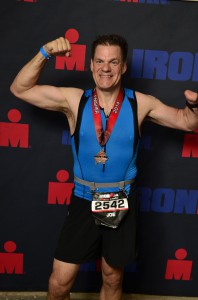

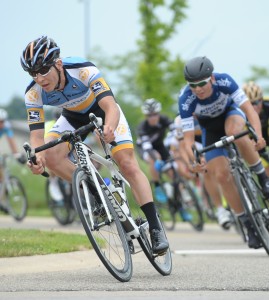
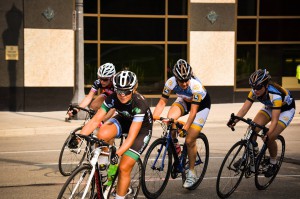


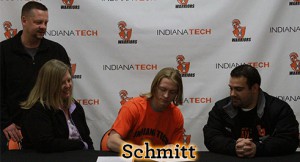
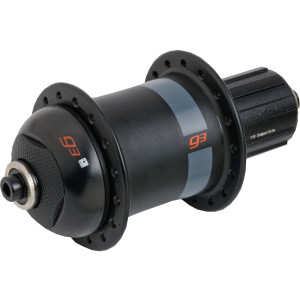 Power Tap was once owned by Tune, but is now property of Cyclops. The device has been improved considerably from its introductory days and remains as the only hub based measuring unit on the market. Power Tap uses the same strain gauge mechanics as many other designs, resulting in the same +/- 1.5% accuracy. Bike to bike moves are easy, and are only a wheel change away. The Power Tap also uses the same popular wireless software (ANT+ Sport) as most other computer head manufactures (such as Garmin) resulting in compatible head units. If you are looking for a device to use on multiple machines, this would be a logical choice. However, if a high-quality racing wheel is needed and power is desired, the hub has to be specially built into it (so no off-the-shelf prebuilt wheels). Unless you wanted to train on this same wheel (which isn’t a usual way to treat an expensive wheel), another training wheel would need to be built, meaning additional cost. Power Tap has recently reduced their pricing significantly, yielding wheels for under $900.
Power Tap was once owned by Tune, but is now property of Cyclops. The device has been improved considerably from its introductory days and remains as the only hub based measuring unit on the market. Power Tap uses the same strain gauge mechanics as many other designs, resulting in the same +/- 1.5% accuracy. Bike to bike moves are easy, and are only a wheel change away. The Power Tap also uses the same popular wireless software (ANT+ Sport) as most other computer head manufactures (such as Garmin) resulting in compatible head units. If you are looking for a device to use on multiple machines, this would be a logical choice. However, if a high-quality racing wheel is needed and power is desired, the hub has to be specially built into it (so no off-the-shelf prebuilt wheels). Unless you wanted to train on this same wheel (which isn’t a usual way to treat an expensive wheel), another training wheel would need to be built, meaning additional cost. Power Tap has recently reduced their pricing significantly, yielding wheels for under $900.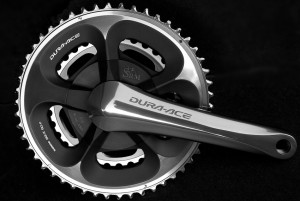 In the area of crank based meters, there are two choices: SRM and Quarq. The first is also the original; German Uli Schoberer released the first SRM in 1987. In developing this power meter, the strain gauges were placed in the spider arm section of a SRM specified crank. SRM is now using off the shelf high-end cranks, like Shimano’s popular Dura Ace, and engineering them to function as power meters. This allows a bike to keep the consistency of a component group (Dura Ace, Ultegra, etc.) and still measure output power in watts. Unfortunately, SRM does not have a user replaceable battery, therefore the unit must be sent back ever 1900 hours of use for replacement. SRM is testing a rechargeable battery that uses a USB port and needs attention after approximately 300 hours or use, but isn’t in production yet. The SRM can be paired with a 3rd party compatible ANT+ head unit, which allows for technology expansion. However, while most head units create an average by measuring one of the four data points every second, the SRM specific Power Control unit measures all four, then averages them for that second. Thus, for shorter measured durations such as a sprint, the Power Control unit provides more accuracy in power measuring. One common feature not on the Power Control unit is GPS. Additionally, SRM uses only the higher end cranks on the market, resulting in the highest prices, with a range from $2,400 to $4,000.
In the area of crank based meters, there are two choices: SRM and Quarq. The first is also the original; German Uli Schoberer released the first SRM in 1987. In developing this power meter, the strain gauges were placed in the spider arm section of a SRM specified crank. SRM is now using off the shelf high-end cranks, like Shimano’s popular Dura Ace, and engineering them to function as power meters. This allows a bike to keep the consistency of a component group (Dura Ace, Ultegra, etc.) and still measure output power in watts. Unfortunately, SRM does not have a user replaceable battery, therefore the unit must be sent back ever 1900 hours of use for replacement. SRM is testing a rechargeable battery that uses a USB port and needs attention after approximately 300 hours or use, but isn’t in production yet. The SRM can be paired with a 3rd party compatible ANT+ head unit, which allows for technology expansion. However, while most head units create an average by measuring one of the four data points every second, the SRM specific Power Control unit measures all four, then averages them for that second. Thus, for shorter measured durations such as a sprint, the Power Control unit provides more accuracy in power measuring. One common feature not on the Power Control unit is GPS. Additionally, SRM uses only the higher end cranks on the market, resulting in the highest prices, with a range from $2,400 to $4,000. The second popular crank-based power meter is the SRAM owned Quarq. This company shipped their first units in mid 2008. Unlike SRM, who incorporates the strain gauges into the one-piece spider/arm of the crank, Quarq looked at the still popular market that had three-piece cranks (spider, left crank arm, right crank arm) and made a replaceable spider that had the necessary electronics. This brought the price down considerably and offered a user replaceable battery, making the product consumer friendly. Quarq offers models using Cannondale, Specialized, and SRAM cranks, and has two new models, the high end Elsa and more affordable Riken. Both have similar electronics, offer the same +/- 1.5% accuracy as other power meters, and no longer need to be recalibrated when chain rings are replaced. The Elsa has lighter crank construction and offers the ability to indirectly measure separate leg strengths. All units use the ANT+ sport licensing, and pricing runs roughly 30 to 40% less then SRMs.
The second popular crank-based power meter is the SRAM owned Quarq. This company shipped their first units in mid 2008. Unlike SRM, who incorporates the strain gauges into the one-piece spider/arm of the crank, Quarq looked at the still popular market that had three-piece cranks (spider, left crank arm, right crank arm) and made a replaceable spider that had the necessary electronics. This brought the price down considerably and offered a user replaceable battery, making the product consumer friendly. Quarq offers models using Cannondale, Specialized, and SRAM cranks, and has two new models, the high end Elsa and more affordable Riken. Both have similar electronics, offer the same +/- 1.5% accuracy as other power meters, and no longer need to be recalibrated when chain rings are replaced. The Elsa has lighter crank construction and offers the ability to indirectly measure separate leg strengths. All units use the ANT+ sport licensing, and pricing runs roughly 30 to 40% less then SRMs.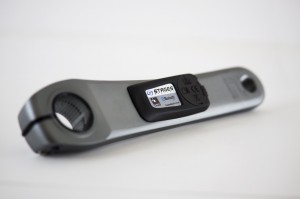 A new player on the market is Stages, who began selling their products in 2012. Like other makers, strain gauges are used. However, Stages’ gauges are located in a single, thin pod that is fastened to a brand specific left crank arm, requiring the replacement of the existing crank arm. The process is simple: replace the arm, pair the 20g meter with your head unit of choice, and that’s it. The system multiplies this single power reading by two to get your total power, making the assumption both legs are similar in strength. Stages states only about 5% of the riders have a significant difference. One drawback is that only metal crank arms are offered, which typically means Shimano. A full range of models exist (105, Ultegra, and Dura Ace), and are very reasonably priced at $600 to $900. These systems are ANT + compatible and have the new Bluetooth transmission. Accuracy is rated at +/- 2%, without factoring in any possible leg discrepancies.
A new player on the market is Stages, who began selling their products in 2012. Like other makers, strain gauges are used. However, Stages’ gauges are located in a single, thin pod that is fastened to a brand specific left crank arm, requiring the replacement of the existing crank arm. The process is simple: replace the arm, pair the 20g meter with your head unit of choice, and that’s it. The system multiplies this single power reading by two to get your total power, making the assumption both legs are similar in strength. Stages states only about 5% of the riders have a significant difference. One drawback is that only metal crank arms are offered, which typically means Shimano. A full range of models exist (105, Ultegra, and Dura Ace), and are very reasonably priced at $600 to $900. These systems are ANT + compatible and have the new Bluetooth transmission. Accuracy is rated at +/- 2%, without factoring in any possible leg discrepancies. The newest player on the market is Garmin’s Vector pedal power meter. This technology was acquired from MetriGear, who showed prototypes at a few yearly conventions but couldn’t get the product to the market. Garmin ran into the same problem, but finally delivered this last year. Obviously, the greatest advantage is portability, as a wrench is all you need to move power-measuring capability from bike to bike. In addition, there is a wealth of knowledge with left and right real time readouts, as well as a total power value. The price is below most crank based units at about $1700, and sneaks in at about 45g more than a normal pedal system. However, the heart of the unit is a Look Keo pedal, so the user should find that mechanism to their liking. As a downfall, the system uses battery life considerably faster then other meters, needing a change every 175 hours. Each pedal requires its own battery, and crashes will likely see your expensive power meter grind across the pavement. Being a Garmin product, the system uses the ANT+ sport software for wireless transmission.
The newest player on the market is Garmin’s Vector pedal power meter. This technology was acquired from MetriGear, who showed prototypes at a few yearly conventions but couldn’t get the product to the market. Garmin ran into the same problem, but finally delivered this last year. Obviously, the greatest advantage is portability, as a wrench is all you need to move power-measuring capability from bike to bike. In addition, there is a wealth of knowledge with left and right real time readouts, as well as a total power value. The price is below most crank based units at about $1700, and sneaks in at about 45g more than a normal pedal system. However, the heart of the unit is a Look Keo pedal, so the user should find that mechanism to their liking. As a downfall, the system uses battery life considerably faster then other meters, needing a change every 175 hours. Each pedal requires its own battery, and crashes will likely see your expensive power meter grind across the pavement. Being a Garmin product, the system uses the ANT+ sport software for wireless transmission.